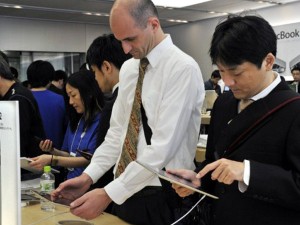Smartphone addicts starting to feel the pain
LONDON – Users of smartphones and tablet computers are starting to get high-tech blues, as increasing numbers of the tech savvy are coming down with ailments from “text neck” to “text thumb injury”.
Health experts in Britain have warned that the strain injuries stemming from long periods spent staring at small screens and tapping at tiny keys can be debilitating. And the injuries are becoming more common as high-tech gadgets grow ever more popular.
More and more Britons use their smartphones – in effect tiny PCs that fit in a jacket pocket – for accessing the Internet rather than making phone calls.
According to a recent YouGov poll, 44 percent of Britons use their mobile phone for activities other than making calls, for between 30 minutes and two hours a day. The pollster quizzed 2,034 adults over several days in September.
“I had a patient who developed inflamed tendons in her thumb from using her smartphone and was unable to use her hand for weeks due to pain,” said Tim Hutchful from the British Chiropractic Association.
Sammy Margo of the Chartered Society of Physiotherapy said that people’s bodies are “not designed to be used like this”.
“The phones are far too small, with keys that are too small,” she said, noting that pain in the upper limbs forced one of her patients to stop texting and instead switch to voice recognition software.
As well as hand injuries, experts point to problems among smartphone and tablet users arising from hours spent leaning over tiny screens.
“The weight of an average human head is between 10 to 12 pounds (4.5 to 5.5 kilogrammes),” said Hutchful.
In an ideal posture, where a vertical line can be drawn from your ear through your shoulder, hip, knee and ankle, “the weight is carried efficiently”, he noted.
But if the head is constantly held forward to squint at a screen, then the unusual posture makes the head feel up to four times heavier, increasing strain across the whole body, he explained.
“Text neck” is in effect the latest manifestation of “repetitive strain injury” (RSI), a condition which affects one worker in 50 in Britain.
RSI is the name given to a group of injuries affecting the muscles, tendons and nerves primarily of the neck and upper limbs. It is particularly prevalent among workers who spend long periods using computers and computer mouses.
It is a treatable condition, but experts warn it is essential not to ignore the early warning signs.
In France, RSI is the main cause of sick leave in the work place.
Emmanuelle Rivoal, a Paris-based physiotherapist and osteopath, is seeing an increasing number of patients who are paralyzed by pain “because they spend more than five hours a day in front of a screen.”
While stressing that he did not want to “demonize smartphones”, Hutchful offered some pointers for gadget aficionados to avoid injury, such as keeping smartphone use at under 40 minutes.
“Keep use to a minimum, take regular breaks and look at different ways of interacting,” such as voice recognition software for texting, he said.
Margo in Britain says the biggest at-risk group are children and teenagers, who are heavy users of the latest computers and phones.
“I know families where people communicate from one room to another via text messages,” she said. “We have to put limits on this.”
